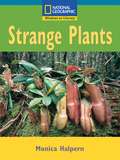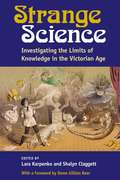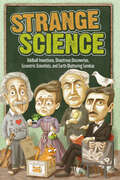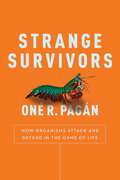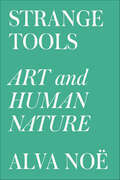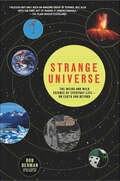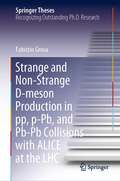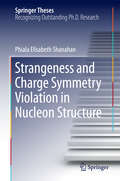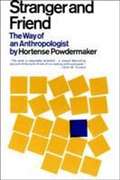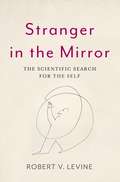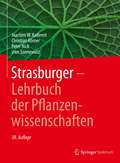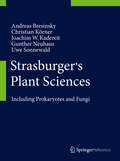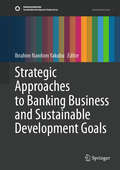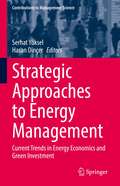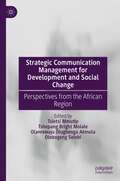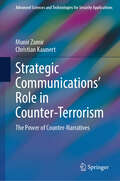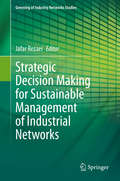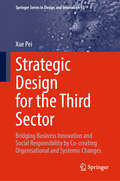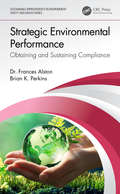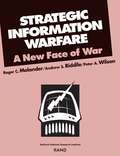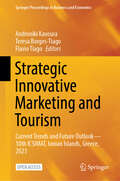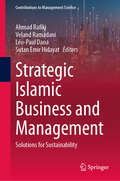- Table View
- List View
Strange Science: Investigating the Limits of Knowledge in the Victorian Age
by Lara Pauline Karpenko Shalyn Rae ClaggettThe essays in Strange Science examine marginal, fringe, and unconventional forms of scientific inquiry, as well as their cultural representations, in the Victorian period. Although now relegated to the category of the pseudoscientific, fields like mesmerism and psychical research captured the imagination of the Victorian public. Conversely, many branches of science now viewed as uncontroversial, such as physics and botany, were often associated with unorthodox methods of inquiry. Whether ultimately incorporated into mainstream scientific thought or categorized by 21st century historians as pseudo- or even anti-scientific, these sciences generated conversation, enthusiasm, and controversy within Victorian society. To date, scholarship addressing Victorian pseudoscience tends to focus either on a particular popular science within its social context or on how mainstream scientific practice distinguished itself from more contested forms. Strange Science takes a different approach by placing a range of sciences in conversation with one another and examining the similar unconventional methods of inquiry adopted by both now-established scientific fields and their marginalized counterparts during the Victorian period. In doing so, Strange Science reveals the degree to which scientific discourse of this period was radically speculative, frequently attempting to challenge or extend the apparent boundaries of the natural world. This interdisciplinary collection will appeal to scholars in the fields of Victorian literature, cultural studies, the history of the body, and the history of science.
Strange Science: Oddball Inventions, Disastrous Discoveries, Eccentric Scientists, and Earth-Shattering Eurekas (Strange Series)
by Editors of Portable PressThis entertaining compendium of bite-sized articles reveals the stranger-than-sci-fi world of strange science. From the oddest theories to the most astounding discoveries to the biggest blunders, Strange Science has all the facts your professors didn't teach you in science class. It's packed with earth-shattering eurekas, outlandish inventions, silly &“scientific&” studies, and the stories behind the weirdos who made it all happen. Put on your lab coat and get ready to discover . . . One dentist's quest to clone John LennonHow to hypnotize a chickenReal-life time travelers (or so they claim)The seven-year-long study that found earthquakes are not caused by catfish waving their tails . . . and other breakthrough findings Plus you&’ll discover unbelievable inventions; the freakiest franken-foods scientists have created; some of Hollywood&’s worst on-screen science blunders; and more! This amazing volume from the Bathroom Readers&’ Institute contains the strangest short science articles from dozens of Bathroom Readers, along with fifty all-new pages.</
Strange Survivors: How Organisms Attack and Defend in the Game of Life
by One R. PaganLife is beautiful, ruthless, and very, very strange. In the evolutionary arms race that has raged on since life began, organisms have developed an endless variety of survival strategies. From sharp claws to brute strength, camouflage to venom—all these tools and abilities share one purpose: to keep their bearer alive long enough to reproduce, helping the species avoid extinction. Every living thing on this planet has developed a time-tested arsenal of weapons and defenses. Some of these weapons and defenses, however, are decidedly more unusual than others. In Strange Survivors, biologist Oné R. Pagán takes us on a tour of the improbable, the ingenious, and the just plain bizarre ways that creatures fight for life. Inside this funny, fascinating field guide to nature&’s most colorful characters, you&’ll meet killer snails, social bacteria, and an animal with toxic elbows. But Strange Survivors is more than a collection of curiosities—it is a love letter to science and an argument for the continuing relevance of this evolutionary battle as we face the threat of resistant bacteria and the need for novel medical therapies. Whether discussing blood-thinning bats and electric fish or pondering the power of cooperation, Pagán reveals the surprising lessons found in some of life&’s natural oddities and how the tactics they employ to live might aid our own survival.
Strange Tools: Art and Human Nature
by Alva NoëA philosopher makes the case for thinking of works of art as tools for investigating ourselvesIn his new book, Strange Tools: Art and Human Nature, the philosopher and cognitive scientist Alva Noë raises a number of profound questions: What is art? Why do we value art as we do? What does art reveal about our nature? Drawing on philosophy, art history, and cognitive science, and making provocative use of examples from all three of these fields, Noë offers new answers to such questions. He also shows why recent efforts to frame questions about art in terms of neuroscience and evolutionary biology alone have been and will continue to be unsuccessful.
Strange Universe: The Weird and Wild Science of Everyday Life—on Earth and Beyond
by Bob Berman"Touches on a dizzying array of subjects, including UV rays, inert gases, fossils, meteorites, microwaves, rainbows . . . Like many a good teacher, Berman uses humor to entertain his audience and liven things up." —Los Angeles TimesBob Berman is motivated by a straightforward philosophy: everyone can understand science—and it's fun, too. In Strange Universe, he pokes into the bizarre and astonishingly true scientific facts that determine the world around us. Geared to the nonscientist, Berman's original essays are filled with the trademark wit and cleverness that has earned him acclaim over many years for his columns in Astronomy and Discover magazines. He emphasizes curiosities of the natural world to which everyone can relate, and dishes on the little-known secrets about space and some of science's biggest blunders (including a very embarrassing moment from Buzz Aldrin's trip to the moon). Fascinating to anyone interested in the wonders of our world and the cosmos beyond, Strange Universe will make you smile and think.
Strange World: Unlocking the Mysteries of Pluto (Fountas & Pinnell Classroom, Guided Reading Grade 5)
by Christy PetersonA New World Discovered It was a faint point of light, almost too small to be seen, moving slowly through the heavens far beyond the known solar system. Scientists got their first glimpse of Pluto almost a hundred years ago—and they have been trying to solve its mysteries ever since. NIMAC-sourced textbook
Strange and Non-Strange D-meson Production in pp, p-Pb, and Pb-Pb Collisions with ALICE at the LHC (Springer Theses)
by Fabrizio GrosaThis thesis provides a comprehensive view of the physics of charmed hadrons in high-energy proton-proton and heavy-ion collisions. Given their large masses, charm quarks are produced in the early stage of a heavy-ion collision and they subsequently experience the full system evolution probing the colour-deconfined medium called quark-gluon plasma (QGP) created in such collisions. In this thesis, the mechanisms of charm-quark in-medium energy loss and hadronisation are discussed via the measurements of the production of charm mesons with (Ds+) and without (D+) strange-quark content in different colliding systems, using data collected by the ALICE experiment at the CERN LHC. The participation of the charm quark and its possible thermalisation in the QGP are studied via measurements of azimuthal anisotropies in the production of D+ mesons. Finally, the prospects for future measurements with the upgraded ALICE experimental apparatus and with more refined machine learning techniques are presented.
Strangeness and Charge Symmetry Violation in Nucleon Structure
by Phiala Elisabeth ShanahanThis thesis discusses two key topics: strangeness and charge symmetry violation (CSV) in the nucleon. It also provides a pedagogical introduction to chiral effective field theory tailored to the high-precision era of lattice quantum chromodynamics (QCD). Because the nucleon has zero net strangeness, strange observables give tremendous insight into the nature of the vacuum; they can only arise through quantum fluctuations in which strange-antistrange quark pairs are generated. As a result, the precise values of these quantities within QCD are important in physics arenas as diverse as precision tests of QCD, searches for physics beyond the Standard Model, and the interpretation of dark matter direct-detection experiments. Similarly, the precise knowledge of CSV observables has, with increasing experimental precision, become essential to the interpretation of many searches for physics beyond the Standard Model. In this thesis, the numerical lattice gauge theory approach to QCD is combined with the chiral perturbation theory formalism to determine strange and CSV quantities in a diverse range of observables including the octet baryon masses, sigma terms, electromagnetic form factors, and parton distribution functions. This thesis builds a comprehensive and coherent picture of the current status of understanding of strangeness and charge symmetry violation in the nucleon.
Stranger and Friend: The Way of an Anthropologist
by Hortense Powdermaker"Her book is all about people. . . . The publishers say of it that 'field work in its personal and objective dimension is placed under a kind of microscope. The book is a must for all field workers in the social sciences. ' That claim does not seem to me excessive. " --Edmund Leach, New York Review of Books "There are few books which are as informative of what it means to be a field-worker in social science as Hortense Powdermaker's Stranger and Friend. This book should be must reading both for scholars and students. " --Seymour M. Lipset, Harvard University "Stranger and Friend is a passionate plea for anthropology as a human discipline as well as a science, as an all-engrossing life experience as well as a profession, and increasingly as a subject in the curriculum of graduate and undergraduate studies. " --Margaret Mead, American Museum of Natural History "This is just the kind of book needed in anthropology today. It tells objectively, but in warm and human terms, how important research was done. It contributes to methodology and to the history of the science of anthropology. " --Charles Wagley, Columbia University" This is an essential book for anyone interested in the problems of an anthropologist at work. " --Cornelius Osgood, Peabody Museum of Natural History
Stranger in the Mirror: The Scientific Search for the Self
by Robert LevineWho are we? Where is the boundary between us and everything else? Are we all multiple personalities? And how can we control who we become?From distinguished psychologist Robert Levine comes this provocative and entertaining scientific exploration of the most personal and important of all landscapes: the physical and psychological entity we call our self. Using a combination of case studies and cutting-edge research in psychology, biology, neuroscience, virtual reality and many other fields, Levine challenges cherished beliefs about the unity and stability of the self - but also suggests that we are more capable of change than we know. Transformation, Levine shows, is the human condition at virtually every level. Physically, our cells are unrecognizable from one moment to the next. Cognitively, our self-perceptions are equally changeable: A single glitch can make us lose track of a body part or our entire body, or to confuse our very self with that of another person. Psychologically, we switch back and forth like quicksilver between incongruent, sometimes adversarial sub-selves. Socially, we appear to be little more than an ever-changing troupe of actors. And, culturally, the boundaries of the self vary wildly around the world - from the confines of one's body to an entire village. The self, in short, is a fiction: vague, arbitrary, and utterly intangible. But it is also interminably fluid. And this unleashes a world of potential. Engaging, informative, and ultimately liberating, Stranger in the Mirror will change forever how you think about your self - and what you might become.
Stranger in the Mirror: The Scientific Search for the Self
by Robert V. LevineIn Stranger in the Mirror, Robert Levine offers a provocative and entertaining scientific exploration of the most personal and important of all landscapes: the physical and psychological entity we call our self. Who are we? Where is the boundary between us and everything else? Are we all multiple personalities? And how can we control who we become?Levine tackles these and other questions with a combination of surprising stories, case studies, and cutting-edge research--from psychology, biology, neuroscience, virtual reality, and many other fields. The result challenges cherished beliefs about the unity and stability of the self--but also suggests that we are more capable of change than we know.Transformation, Levine shows, is the human condition at virtually every level. Physically, our cells are unrecognizable from one moment to the next. Cognitively, our self-perceptions are equally changeable: A single glitch can make us lose track of a body part or our entire body--or to confuse our very self with that of another person. Psychologically, we switch back and forth like quicksilver between incongruent, sometimes adversarial subselves. Socially, we appear to be little more than an ever-changing troupe of actors. And, culturally, the boundaries of the self vary wildly around the world--from the confines of one's body to an entire village.The self, in short, is a fiction--vague, arbitrary, and utterly intangible. But it is also interminably fluid. And this, Levine argues, unleashes a world of potential. Fluidity creates malleability. And malleability creates possibilities.Engaging, informative, and ultimately liberating, Stranger in the Mirror will change forever how you think about your self--and what you might become.
Strasburger − Lehrbuch der Pflanzenwissenschaften
by Christian Körner Peter Nick Joachim W. Kadereit Uwe SonnewaldSeit 120 Jahren liegt die Stärke des STRASBURGERs in der ausgewogenen Darstellung aller Teilgebiete der Pflanzenwissenschaften. In der vorliegenden 38. Auflage sind besonders die Teile Struktur und Entwicklung stark überarbeitet worden. • Der Teil Struktur beschreibt den pflanzlichen Aufbau ausgehend von der Ebene der Zelle über die Gewebe bis hin zur Ebene der Organe. Bei der Neufassung dieser Kapitel war es ein besonderes Anliegen, Struktur als Ausdruck von Funktion sichtbar zu machen. Neben einer Beschreibung der Formen wurde versucht, die Erklärung dieser Formen stärker zu gewichten. Der Teil Genetik wurde neustrukturiert und aktualisiert. • Der Teil Genetik wurde neustrukturiert und aktualisiert. Insbesondere die Bereiche Epigenetik und Gentechnik wurden erweitert. Hier spielen Weiterentwicklungen der Gentechnik zur gezielten Genomveränderung eine Rolle. Die methodischen Hintergründe werden im neuen Abschnitt Genomeditierung beschrieben.Der ebenfalls neu gestaltete Teil Entwicklung spiegelt die im Teil Strukturbehandelten Ebenen (Zelle, Gewebe, Organ, Organismus) wider, wobei das Werden dieser Ebenen im Mittelpunkt steht. Es werden zentrale Konzepte der Entwicklungsbiologie an Beispielen aus dem Pflanzenreich geschildert. In den anschließenden Kapiteln geht es dann um die Steuerung dieser Vorgänge durch Phytohormone und den Einfluss endogener und exogener regulatorischer Faktoren.• Im Teil Physiologie werden ausgehend von der Beschreibung grundlegender Transport- und Stoffwechselprozesse die Anpassung des pflanzlichen Stoffwechsels an entwicklungs- und umweltbedingte Veränderungen betrachtet. Die Abschnitte zum Primärstoffwechsel wurden ergänzt und überarbeitet und die übrigen Teile aktualisiert.• Der evolutionäre Prozess, die Phylogenie und Systematik der Pflanzen und anderer photoautotropher Eukaryoten sowie die Geschichte der Vegetation der Erde sind Inhalt des Teils Evolution und Systematik. • Im Ökologie-Teil wird die Pflanze in Beziehung zu den Lebensbedingungen am Wuchsort gesetzt. Pflanzliche Reaktionen auf Klima und Bodenfaktoren, Prozesse in Populationen und Artengemeinschaften sowie die großen Vegetationszonen der Erde werden erklärt. In dieser neu überarbeiteten Auflage wurden einige Abbildungen und Textstellen hinzugefügt sowie die Literatur aktualisiert.Der Tradition dieses einzigartigen Standardwerkes entsprechend soll es Studierenden als vierfarbig bebildertes Lehrbuch und Dozenten aller bio-, umwelt- und agrarwissenschaftlichen Fachrichtungen als verlässliches Nachschlage- und Referenzwerk dienen.
Strasburger's Plant Sciences
by Christian Körner Joachim W. Kadereit Andreas Bresinsky Gunther Neuhaus Uwe SonnewaldThis famous book on botany was published for the first time in 1894 by Eduard Strasburger and his co-workers. The present edition is based on a translation of the 36th edition of the German "Strasburger" and contains additional contributions by renowned experts in the field. The Strasburger comprises a highly appealing and holistic approach to the structure, the systematics and evolution, the functioning, and ecology of plants. The book covers 14 chapters bundled into four main sections: (i) Molecular and morphological structure of plants and cells (ii) Physiology and metabolism (iii) Evolution and systematics of plants (iv) Ecology"
Strategic Approaches to Banking Business and Sustainable Development Goals (Sustainable Development Goals Series)
by Ibrahim Nandom YakubuThis book offers a comprehensive exploration of strategic approaches to banking within the context of sustainable development goals (SDGs). In a world grappling with urgent social, environmental, and economic challenges, banks have a unique role in contributing to sustainable development. This book bridges the gap between theory and practice, offering a strategic framework that enables banks to integrate the SDGs into their decision-making processes. Divided into five parts, it covers essential topics such as green finance, financial inclusion, ethical banking, remittances, and macroeconomic stability, providing a comprehensive understanding of the role of banks in sustainable development. Through case studies, empirical research, and theoretical insights, the book offers practical guidance for aligning banking business strategies with SDGs. Whether you are a banking professional seeking to align your institution's practices with sustainable development, a policymaker crafting regulations for responsible banking, a researcher exploring the potential of sustainable finance, or a student aspiring to understand the role of banks in driving positive change, this book provides essential insights and guidance for leveraging the power of banking to create a more sustainable future. It will also appeal to multinational organizations like the IMF and World Bank, as well as monetary authorities, including central banks. It combines rigorous analysis with practical recommendations, making it an essential resource for anyone interested in the intersection of banking and sustainable development.
Strategic Approaches to Energy Management: Current Trends in Energy Economics and Green Investment (Contributions to Management Science)
by Hasan Dinçer Serhat YükselThis book introduces current managerial approaches to energy production and energy use. The volume analyses how to manage technological developments that contribute to lowering the price of energy production and also focuses on the impact renewable energy sources that provide continuity in energy production and how to manage it. The book presents studies on the effectiveness of wind, solar, biomass, geothermal and hydroelectric energies and discusses current technological approaches to prevent environmental pollution such as carbon capture and storage. Furthermore, the book includes sustainable economic and financial strategies to use energy more effectively and efficiently. It thus appeals not only to an academic readership but also to energy management professionals working in this field.
Strategic Communication Management for Development and Social Change: Perspectives from the African Region
by Tsietsi Mmutle Tshepang Bright Molale Olanrewaju Olugbenga Akinola Olebogeng SelebiThis book is the first of its kind within the African region to combine scholarly perspectives from the fields of Strategic Communication Management and Communication for Development and Social Change. It draws insights from scholars across the African continent by unravelling the complementary nature of scholarship between the two fields, through the lens of prevailing governance and sustainability challenges facing African countries, today. This edited volume covers issues that have adversely affected the achievement of goals related to humanitarian upliftment, development and social change for all African nations. Consequently, citizen participation, which lies at the heart of these challenges when considering the question of sustainable governance and policy development for social change in an African context is addressed. To this end, a reflection is also made on various case studies that exist where local citizens do not inform sustainable development programmes, while the promotion of bottom-up development and social change is largely replaced by top-down instrumental action approaches and hemispheric communication instead of strategic communication. Themes explored include: ● Communication for social change, bottom-up development and social movements in the local government sphere ● Strategic communication in governance, planning and policy reforms ● The role of multi-stakeholder partnerships in achieving development of objectives geared towards good governance in Africa ● Public participation, protests, and resistance from 'below' ● Public sector health communications and development ● Media relations, accountability and contested development narratives with the Fourth Estate ● Social media and eParticipation in government development programs.
Strategic Communications' Role in Counter-Terrorism: The Power of Counter-Narratives (Advanced Sciences and Technologies for Security Applications)
by Christian Kaunert Munir ZamirThis book examines the use of communications efforts in preventing and challenging extremist narratives online. These efforts are part of the expansive and well-resourced sector of preventing and countering violent extremism (P/CVE). They leverage technology tools (algorithms, direct messaging, and audience targeting) to communicate counter-extremist messaging across various digital platforms. The research and discussion focus on the role of strategic communications in deradicalizing and changing the behavioral features of ‘vulnerable’ and ‘at-risk’ audiences susceptible to extremist messaging. This approach views radicalization pathways toward violence as a key issue to tackle within online P/CVE communication efforts. This book investigates this problem and seeks to understand and assess the role, efficacy, and implications of such efforts within the broader counter-terrorism (CT) landscape, using UK counter-terrorism efforts (via the Prevent Strategy) as its primary contextual source. This analysis applies the theory of socialization, referred to in this study as ‘socialization and reasoned action strategic communication’ (SoRaSCo). The authors identify strategic communications deficiencies and offer insights for developing a roadmap for strategic communications in P/CVE in the UK and globally. Drawing on extensive research, the book provides crucial insights for policymakers, researchers, and the public interested in new trends in P/CVE, counter-terrorism, strategic communications, and policing interventions.
Strategic Decision Making for Sustainable Management of Industrial Networks (Greening of Industry Networks Studies #8)
by Jafar RezaeiThis book presents a diverse set of decision-making methodologies to solve some of the most important decisions that most organizations face today. It is an excellent demonstration of some great challenges in our society in the area of sustainability. These great challenges, ranging from sustainability in logistics to the use of renewable energies, needs to be urgently addressed. Sustainability has become one of the most important topics in management and many organizations are taking big steps towards sustainability. Organizations are attempting to use cleaner production technologies and renewable energies sources, to improve health and safety issues within their industries and the products and services they offer. These points involve several important strategic and managerial decisions, highlighted in this book. The book can be used by decision-makers and policy-makers as exemplary guidelines to solve sustainability problems.
Strategic Design for the Third Sector: Bridging Business Innovation and Social Responsibility by Co-creating Organisational and Systemic Changes (Springer Series in Design and Innovation #55)
by Xue PeiThis book discovers and demonstrates the strategic values of design within the context of the third sector, a domain characterized by inherent complexity and the objective of effecting positive transformations across both economic and social dimensions. Based on seven years of research, it combines theoretical insights with hands-on empirical studies, offering a compelling narrative on the evolving roles of strategic design in third sector organisations. Through an in-depth analysis of best practices and four action research projects, the book showcases how design enables third sector organisations to uncover opportunities, manage innovation processes, and facilitate meaningful collaboration among diverse stakeholders. At its core, it introduces a design framework to illustrate how a strategic design mindset, together with methods and tools, fosters stakeholder participation and co-creation in the innovation process, and how it inspires conversations and reflections on organizational and systemic changes. The framework also offers actionable strategies for design researchers and practitioners willing to apply strategic design for addressing complex societal problems through creativity, innovation strategy and a systemic lens.
Strategic Engagement in Global S&T: Opportunities for Defense Research
by Committee on Globalization of Science Technology Opportunities Challenges for the Department of DefenseAccording to recent reports, the United States currently accounts for less than one-third of global research and development spending, and it is projected that this fraction will decline to 18% by 2050. These statistics, compounded by the recognition that the United States no longer maintains technological superiority across all research fields, highlight the need for the U. S. research community to stay abreast of emerging science and technology (S&T) around the world, to leverage others' investments, and to seek out collaborations in areas where researchers need to remain at the leading edge. The United States' Department of Defense (DoD) has long relied on its historical technological superiority to maintain military advantage. However, as the U. S. share of S&T output shrinks and as the U. S. defense research enterprise struggles to keep pace with the expanding challenges of the evolving security environment and the increased speed and cost of global technology development, the DoD must reexamine its strategy for maintaining awareness of emerging S&T developments occurring around the world. To fully leverage these advances and to make strategic research investments, the DoD must assess with whom and in which areas it should collaborate. To delve more deeply into the implications of the globalization of S&T and of international S&T engagement for the DoD, the Office of Naval Research, the Air Force Office of Scientific Research , and the Office of the Deputy Assistant Secretary of the Army for Research and Technology asked the National Research Council to assess current DoD strategies in the three Services - Army, Air Force, and Navy - for leveraging global S&T and for implementing and coordinating these strategies across the department. Strategic Engagement in Global S&T assesses the opportunities and challenges stemming from the globalization of S&T and the implications for the DoD and its Services. This report considers DoD strategies in the three Services for leveraging global S&T and implementation and coordination of these strategies across DoD. The report explores models for global S&T engagement utilized by other domestic and foreign organizations. Strategic Engagement in Global S&T assesses how the ongoing globalization of S&T may impact research funding and priorities and workforce needs, as well as issues of building and maintaining trusted relationships and avoiding technology surprises. This report will be of interest to researchers and industry professionals with expertise in the globalization of science and technology, international engagement, the defense research enterprise, program evaluation, and national security.
Strategic Environmental Performance: Obtaining and Sustaining Compliance (Sustainable Improvements in Environment Safety and Health)
by Frances Alston Brian K. PerkinsProtecting our environment has never been more important than it is today in the wake of climate change and the ever-increasing demand on natural resources due to the expanding world population. Environmental protection has been increasingly discussed by concerned citizen groups and politicians in the wake of unexpected environmental disasters that have occurred in recent years. The need to protect drinking water resources, control greenhouse gas emissions, and implement successful waste reduction practices will continue to gain visibility with growing social awareness. Environmental managers and leaders can all benefit from this comprehensive and strategic book which guides them through environmental regulatory requirements and methods that can be used to interpret the regulations, develop programs, and processes to ensure compliance. The book includes a Tool Kit containing resources that can assist a company in assessing and evaluating the strength of their environmental program, systems, and processes so that changes can be made before damages to the environment becomes a reality, and penalties are enforced.
Strategic Information Warfare: A New Face of War
by Andrew Riddile Stephanie Williamson Peter A. Wilson Roger C. MolanderFuture U.S. national security strategy is likely to be profoundly affected by the ongoing, rapid evolution of cyberspace--the global information infrastructure--and in particular by the growing dependence of the U.S. military and other national institutions and infrastructures on potentially vulnerable elements of the U.S. national information infrastructure. To examine these effects, the authors conducted a series of exercises employing a methodology known as the Day After ... in which participants are presented with an information warfare crisis scenario and asked to advise the president on possible responses. Participants included senior national security community members and representatives from security-related telecommunications and information-systems industries. The report synthesizes the exercise results and presents the instructions from the exercise materials in their entirety.
Strategic Innovative Marketing and Tourism: Current Trends and Future Outlook—10th ICSIMAT, Ionian Islands, Greece, 2023 (Springer Proceedings in Business and Economics)
by Androniki Kavoura Teresa Borges-Tiago Flavio TiagoThis open access book presents the latest findings of researchers from around the globe who presented their work at the 10th international conference of Strategic Innovative Marketing and Tourism (ICSIMAT) in 2023. It provides an up-to-date information and discusses current trends, issues, and debates, both theoretical and practical research, on strategic innovative marketing and tourism and applications from social media and emerging technologies in Artificial Intelligence and the Internet of Everything. Topics covered in the chapters include social media in marketing and tourism hospitality, culture, strategic tools, and techniques employed and implemented by some of the top research laboratories in the world to the industry. This book brings together work from both academia and industry and continues the successful impact of the previous years' conference on the academic discussion of the topics.
Strategic Islamic Business and Management: Solutions for Sustainability (Contributions to Management Science)
by Sutan Emir Hidayat Léo-Paul Dana Veland Ramadani Ahmad RafikiIn the contemporary global market, this book underscores the significance of Islamic institutions and companies to employ effective business and management strategies for sustained success. It provides a thorough examination of diverse facets of Islamic business and finance, including organizational aspects, strategic planning, marketing, entrepreneurship, and innovation. Rooted in the principles of Islamic religious law, the text presents a range of concepts, models, and frameworks to enhance the performance of Islamic organizations. From historical insights to contemporary adaptations, the book highlights the crucial role of a just system in ensuring sustainability within the banking sector and broader business context. The emphasis on ethical practices, stakeholder considerations, and technology integration advocates for strategic approaches that enhance competitiveness while adhering to values of sustainability. With a specific focus on topics such as digital marketing, the book navigates the utilization of technology for optimized customer reach and campaign performance. A pertinent resource for entrepreneurs, practitioners, policymakers, academicians, and students interested in formulating effective strategies in Islamic business, management, and digital marketing to promote sustainability and ethical practices.
